1/48th Hasegawa F6F-3 Hellcat
When I saw the actual photo of this plane, I just knew I had to build it. Other than the quite unusual white paint trim, it's pretty much a standard WWII tri-color Hellcat. I know it was from a Navy squadron but I have yet to identify which one. In any event, it was a pretty straight-forward build with no complications. In my opinion, the Hasegawa kit is one of the best Hellcat models currently available. I built mine pretty much out of the box with the exception of an Eduard color cockpit set, True Details weighted wheels (trimmed down a bit) and the rear vac canopy also from True Details. The kit canopy would not allow it to be installed in the open position and I wanted to have it open. The model is airbrushed with Model Master enamel paint. The decals came from 'ye ole decal stash box except for the plane's name 'Lolly' and the pilot's name which were custom printed for me. The final photo in the batch is a shot of the actual plane out in the South Pacific in 1944.
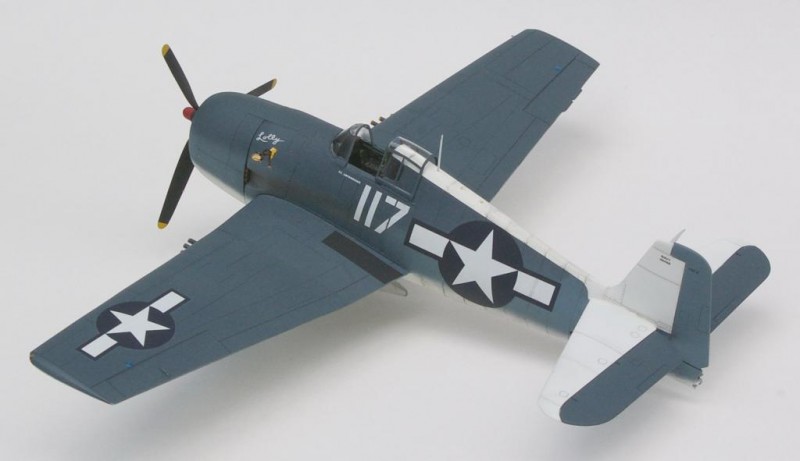
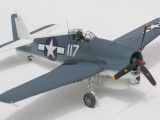
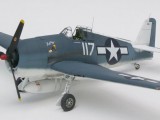
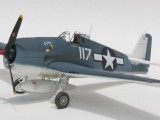
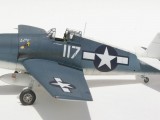

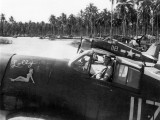

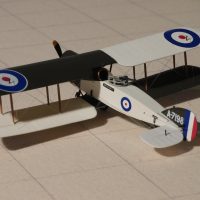

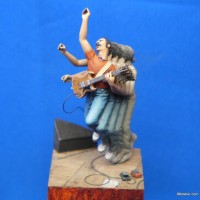
Very nicely done, Jim...the fact that it's tri-color almost escaped me had I not read the narrative first. A very (very), subtle transition in the two blues - or is the lighting that's affecting my judgement?
Odd squadron marking all the way down the spine, huh? Wonder if it had a two-fold meaning or even another purpose?
Let us know if you uncover anything interesting.
Thanks Craig...those odd squadron markings were what compelled me to build it. One of my associates suggested that the Navy squadron to which it was assigned belonged to the same headquarters command that had the white tail and fuselage seen on some P-39's and P-40's. I can't confirm that as of yet but it seems a plausible explanation. Perhaps one of these days the actual facts will come out.
@Craig That's probably fading due wear and weather exposure. Land-based aircraft in the Pacific were at the tail end of the supply lines, so all the attention went to just keeping the birds in the air. Little details like the paint job were generally not even a concern, often because they just didn't have the paint to keep them all nice and touched-up like aircraft in Europe had (you saw the same thing in North Africa as well). Sand and crushed coral kicked up by propellers wreak havoc on paint, not to mention spending months under the tropical sun.
Just look up photos of the Marine Corsair squadrons and check out how beat-up those birds got (the pic of Boyington in BuNo. 17883 is a great example of this). On some of them, the non-specular sea blue tops (semi-gloss sea blue on the wing uppers, however) have almost completely faded into the intermediate blue vertical surfaces. If the paint hasn't been blasted off down PAST the primer altogether.
Very cool Jim…..nice to see a Hellcat in an unusual scheme. Nice build and photos are nice as well.
Thanks Jack, I appreciate your comments.
sweet piece of work
Thanks Bob.
Yep, that white trim is quite natty. Nice model.
Thanks Bill.
Very nice Hellcat. As Craig said the paint work is very subtle & probably closely reflects an aircraft that lives in the sunshine.
Thanks Al. Many of the planes out in the South Pacific seem to have weathered quite quickly. I've seen photos of Corsairs where the demarcation between the dark sea blue and intermediate blue was all but indistinguishable. That was the effect I was trying to achieve on that Hellcat model.
Excellent Hellcat Jim, paint work is really nice. Wouldn't bet the farm on it but from your reference photo I'd say it's from a Marine Squadron
Hello Rick...Thanks for your comments. I may be revealing/confirming my ignorance here but I'm unaware of any Marine squadrons. other than the night-fighting units, that flew Hellcats out in the South Pacific islands during WWII. Since I can't yet confirm the squadron that Hellcat flew with, I certainly remain open to any input.
Like the scheme a lot Jim. Excellent paint job. Rare to see many other schemes on Hellcats other than overall blue or tricolor. Thanks for sharing it. very sharp.
Thank you Paul.
White tails on P-39s and P-40s were a SWPA 5th AF phenomenon in New Guinea to distinguish them from Ki-61s, while white tails on P-47s were also 5th AF to distinguish them from Oscars(!).
There weren't that many land-based Hellcats in SoPac (I think only two), so this might have been a marking used there for similar purpose to what was done in New Guinea, to distinguish from Japanese radial-engine types.
Nice work on the model.
"...There weren’t that many land-based Hellcats in SoPac (I think only two)..."
Did you mean two Squadrons or only 2 airplanes...?
I can see at least 6 in that last pic.
Thanks Tom, I'm still trying to nail down the squadron those Hellcats belonged to.
Jim,
Beautiful job on that unusual looking Hellcat. I had never seen that color scheme with the white spine, fin and stabilizer. Thanks!
Thanks Robert. The actual photo of that Hellcat was what motivated me to build that model. I had seen a couple of other photos of white spine F6F's with a slight difference of the paint application but the one I modeled came from the photo which appealed to me the most.
A nice Hellcat, with interesting markings that will stand out of your collection.
Thanks Bernd.
Very unusual and interesting scheme. You've done a great job on the old Hasegawa kit.
Hello Nikola and thank you for your comments. Even though that Hasegawa Hellcat kit has some age on it, it's still a fine kit to work with. I wish I had dropped the flaps on it but I'll save that for the next one.
Lovely Hellcat Jim, well painted and finished
Well done Jim.
Thank you Simon.
Looks very, Jim, like the others have said, it's good to see an unusual colour scheme, and it really suits this Hellcat.
Thanks George.
Great scheme and nice work!
Thank you John.
Jim, another outstanding build. The three tone scheme is right on and the custom markings are the icing on the cake. I surely agree with you about the quality of the Hasegawa Hellcats and I have one on the assembly line myself and a few more in the stash. Great job as usual. Clark
Thanks Clark...My comment about preferring the 1/48th Hasegawa F6F-3 was not meant to dog other manufacturers kits but just a personal preference. I've built both the Eduard -3 and -5 and they are well-engineered kits, but I still prefer the Hasegawa version. I look forward to seeing your Hellcat when you get her finished.
I love the fail by the artist who made the decals. Nice big photo of the pinup on the side of that plane, and he still gets it wrong.
D'oh, missed the part where you said the pinup decal came from somewhere else.
Jim,
Regardless of where the markings come from this is a great, no, outstanding build. I really like how you do USN and USMC aircraft.
Thanks Frank and I appreciate your fine compliments on that Hellcat build. I have since found out that the F6F-3 I modeled from that photo included with the original post actually belonged to Navy squadron VF-38. I also 'discovered' a couple of additional photos of Hellcats in those markings. If you like, drop me an email at corsairjim@att.net and I'll be glad to share those with you.
Jim,
Any idea where the photo of Lolly was taken?
Hello Michael...I have been unable to determine the name of that island location where 'Lolly' was seen in that photo. I do have a couple of additional photos of those white-spined Hellcats that are identified as being taken on Green Island. That may or may not be the location where that shot of 'Lolly' was taken. Sorry that I can't nail down any more info info at this time. I'd love to know too.
Jim I love that Hellcat. Its always nice to see something different . That finish came out really great 🙂
Cheers Brian
Thanks Brian, I enjoyed that build as that Hasegawa Hellcat kit was a pleasure to work with. I plan on doing a few more of them somewhere not too far down the line.
Found this info posted with the same black and white photo you posted here:
Lt. Lochridge in his F6F-3 #117 "Lolly" of VF-33 at Turtle Bay strip on Espiritu Santo.
Wow! What awesome posts and a great build! I have been researching an F6F that my friends' great uncle flew. We want to build a foam RC model of his F6F but all we have is this pic to go on. Your build and the subsequent post really helped us out. It even looks like the VF38 squadron patch was on the side oof the plane even though it's blown out in the photo. And to confirm, he was Navy. Thanks all!
2 attached images. Click to enlarge.